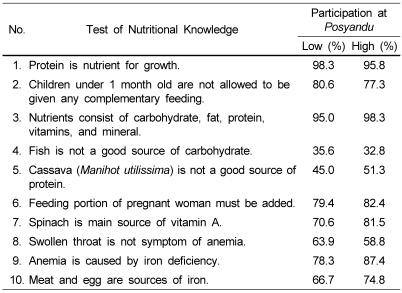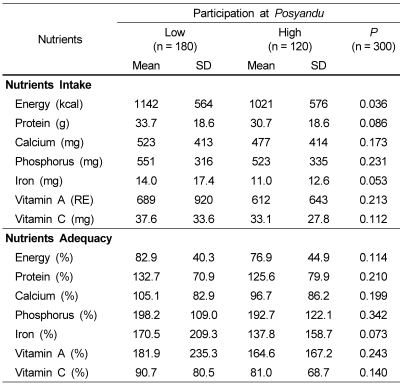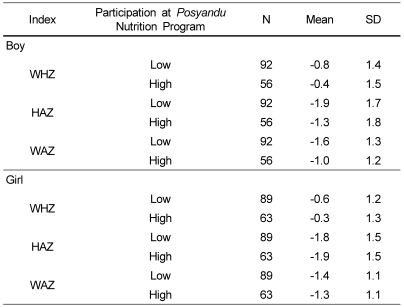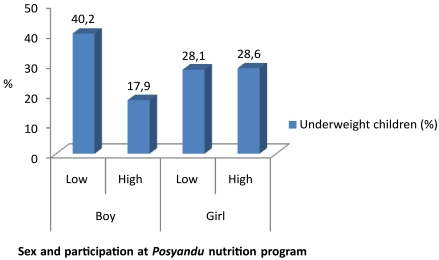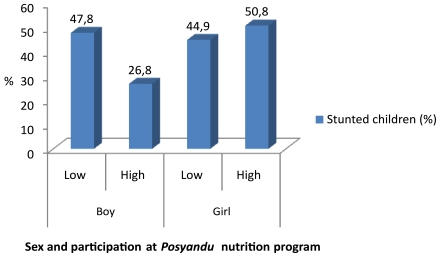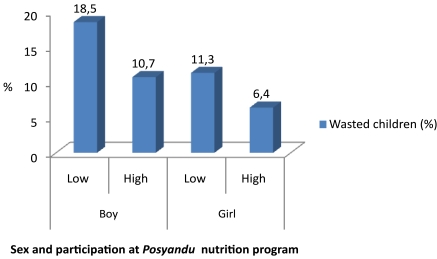Abstract
The objective of this research was to analyze nutritional status and food consumption of children participating in the Posyandu nutrition program. A total sample of 300 children under five years had been drawn. Sample was divided into two categories namely high participation and low participation in the Posyandu nutrition program. The sample was selected from two sub districts of Cianjur District, West Java. The districts were areas with a high proportion of poor people and many of them take the benefits of Posyandu nutrition program conducted by the government. The participation of children (under five years old) in visiting Posyandus was relatively good, namely, 92.4% (for the high participation group). However, for the low participation group, the number of participating children was relatively low (28.3%). The average consumption of energy for children under five years old was still below the recommended dietary allowance < 80% of RDA, whereas the protein consumption was already above the RDA. The prevalence of underweight, stunting, and wasting among children were respectively 30.0%, 43.7%, and 12.3%. The activities at Posyandus had a positive impact on the nutritional status of children under five years olds, measured in terms of weight for age (W/A) and weight for height (W/H). The more frequent the visit to Posyandus, the better the nutritional statuses would be.
Keywords: Food consumption, nutritional status, children under five years
Introduction
Malnutrition leads to a reduced quality of human resources. A lack of nutrition will cause a slow-down of physical growth, mental development, intelligence, decreased productivity, increased diseases and deaths [1]. Malnutrition is not simply the result of inadequate food availability or inadequate access to health services and sanitation. The quality of care and feeding offered to children which is critically dependent on women's education, social status and workload, is now seen as a significant contributing factor [2].
At the level of households, the nutritional status is affected by the household ability to provide adequate food in both quantity and quality, mother's pattern of upbringing children, knowledge of nutrition, and other socio-cultural factors. This indicates a close relation between food security along with its nutritional status and public health. Therefore, efforts in improving food security and a community nutrition must become a global commitment. In the International Conference on Nutrition 1992 and World Food Summit 2002, it was confirmed that it is necessary for each nation including Indonesia to have commitment to continue to improve food security, to eliminate poverty and malnutrition [1].
A nutritional status is a determinant factor of living quality and work performance. A high infant mortality rate, children under five years old and pregnant women, and a decreased work performance as well as retarded mental development and intelligence are as a result directly or indirectly of malnutrition.
The improvement of nutrition is the main prerequisite for the improvement of pregnant women's health, the reduction of high infant mortality rate and children under five years old, the assurance of physical growth, social and mental development of children, work performance, and academic achievement. Therefore, the status of community nutrition is one important parameter of human resource quality.
National efforts in improving nutrition in Indonesia have been running for thirty years and are still focused on the major problems of nutrition, protein energy malnutrition (PEM), vitamin A deficiency (VAD), iron anemia and iodine deficiency disorders (IDD). Nutritional improvement has succeeded in reducing the four major nutritional problems, but is closely related to the efficiency of cross-sector efforts such as poverty elevation. Nutrition programs need supports by making efforts in improving motivation, knowledge and skills of cadres, participation of families and public figures so that facilities and infrastructure of nutrition programs provided by the government can bring out optimal results [3].
The nutrition program at district level is a part of national nutrition program. The national policy of nutrition program consists of 4 sub programs: program on protein-calorie malnutrition, program on iron-anemia, program on vitamin A deficiency, and program on iodine deficiency. All of these are implemented at district level, and the government of Indonesia determines the objectives are as follows: reducing prevalence of protein-calorie malnutrition among children to 20%, reducing iron-anemia of pregnant women to 40%, there is no clinically vitamin A deficiency of pregnant women, and increasing consumption of iodized-salt to 90% household. Implementation of nutrition program at community level is through Posyandu (Integrated Health and Nutritional Services).
Posyandu (Health and Nutrition Integrated Service Center) is a center which is run by the community and which provides services, such as Family Planning, Mother and Child Health, Nutrition (growth monitoring, supplemental feeding, vitamin and mineral supplementation, and nutrition education), Immunization, and Diarrhea Disease Control. Posyandu is supported by government (Ministry of Health as the leading sector, supported by Family Planning Board, Ministry of Internal Affairs, etc.). Posyandu program in Indonesia was started in 1980s. One Posyandu serves to approximately 50 children under 5 years of age, or its services are adjusted to the capability of the cadres and to local conditions, such as geographical conditions, distance between dwellings, number of households, etc. The Posyandu program is conducted every month in every village level. The operational of Posyandu is supported by medical doctor or midwife from sub district clinic and cadre or village health post volunteers.
In the Posyandu nutrition program vitamin A supplementation was given to infants and under five children twice a year in February and August. This program adopted the vitamin A supplementation program by WHO/UNICEF/IVACG [4]. This calls for children aged 6-12 months to receive a 100,000 IU dose, and for children aged 12 months and over to receive a 200,000 IU dose of vitamin A once every four to six months. Fifteen countries use alternative supplementation regimens in which a lower dose, usually 50,000 IU, is provided. Coverage has been increased in recent years by providing supplements during National Immunization Days (NIDs) or other mass campaigns such as periodic anti-helminth campaigns. Thirty-four of 78 countries which have used NIDs for delivery increased coverage rates of children under five [5].
The occurrence of malnutrition is often overlooked from our common observation, but a closer look will indicate high death rates of mothers, babies, children under five, and a low life expectancy. Participation in the Posyandu program should be considered as being important, because the program has been run since 1980s and people should be aware of it. However, children participation in the Posyandu program usually decreases after children reach two years of age. Children are supposed to participate in the Posyandu until five years old.
For this reason, the study is intended to answer some questions: (1) will participation in the Posyandu program improve nutrition knowledge of mothers? (2) are there any differences among nutrient intake of high and low participation in the Posyandu program? (3) will children under five years improve their nutritional status after visiting Posyandu regularly?.
Materials and Methods
Location
This study was carried out in the district of Cianjur, West Java Province, Indonesia. Cianjur district was selected since there were variations in nutrition program implemented and variations in achieving the program objectives. The two sub districts of Cianjur district (Karang Tengah and Ciranjang) were the areas with a high portion of poor population and many of them utilized the nutrition programs offered by the government. Those sub district were chosen to increase heterogeneity of samples, so that the performance of nutrition program was truly represented by the selected samples.
Subjects
This research used a cross-sectional design with samples of households who had children under five. The group samples had taken benefit with a various intensity from the Posyandu nutrition program. Population studied in this research was children under five years old. The steps in taking samples were as follows collecting a list of names of under-five-years-old children from Posyandu cadres. Posyandu cadres were asked to mark under-five-year-old children who visit Posyandu for the last six months as high frequency (visits of 4-6 times) and low frequency (visits of 1-3 times). Number of visit was considered as stratum in this sampling technique used. A total number of 300 under-five-years children was chosen. Samples were taken through stratified random sampling with proportional allocation where high and low frequency visit stood as stratum.
Data collection
Data consist of socio economic status of household, nutrition knowledge of mothers, children food intake, and children nutritional status. Socio economic and nutrition knowledge data was collected by interviewing respondent face to face using questionnaire. Food intake data was collected by 1×24 hours food recall. Anthropometry data was collected by weighing and measuring body height. Weight was measured with electronic scale, and the scale was periodically calibrated. All subjects were examined shoeless in light clothing only. Length/height was measured with infant length/height measuring boards which recommended by WHO.
The nutritional status in this research was based on the resulted measurement of body weights and heights, so the analysis uses the weight for age (W/A), height for age (H/A), and weight for height (W/H). The data processing used WHO Anthro 2005 software [6].
Statistical analysis
The predictions of means and standard deviation were made for all variables. The prediction of proportion had been calculated for all categorized variables. All parameter predictions have been made for the respondents who utilize nutrition programs greatly (high frequency visits) and the respondents with a low utilization (low frequency visits). To analyze more deeply, the regression analysis was used.
Results
Socio economy of household
Parents' and children age
Age is one of the important factors that affect a person's productivity. A young person tends to have a higher productivity than an old one because of the youth's better physical and health condition. In terms of the age of young parents having children under five years, both mothers and fathers were still in the productive age, that is, on average 30.8 years for mothers and 36 years for fathers. The average age of children in the research location is 2.7 ± 1.0 years, with lowest age of 1 year and the highest age of 5 years. The average age is relatively the same in both low and high participation groups.
Household size
A family is a group of people living together in a home and having a blood relationship. The household size with a low participation was included in a medium category of family (5-7 members), while that with a high participation was in the small category of family (≤ 4 members). This is because the fewer the family members, the better the mother's attention to children care and health tend to be.
Education of husband and wife
Husbands took on average nine years of schooling (equivalent to secondary school graduates) and wives spent 8.2 years (equivalent to the second year of secondary school). The educational level of husbands and wives was of low category because it was only equivalent to the compulsory program of schooling set by the National Department of Education that is nine years. Despite the low education, most husbands and wives (≥ 95%) could read and write, which was taught in the elementary school level. This indicates that husbands and wives could receive information through printed media.
Income
A job is a source of family income. With the presence of permanent jobs, a family is guaranteed of a monthly income. If a family does not have a fixed job, the family's monthly income cannot be assured. Labour was the type of employment mostly taken by husbands (30.1%). It was the type of job with relatively limited income despite the various range of income, from factory's formal workers to those in services companies, with uncertain income. The majority of wives did not work outside home or work as housewives (81.0%). This shows that the income in the family of children under five years old was mainly from the husband's job.
Expenditure
The monthly food expenditure in family of children under five years old was IDR 181,603 or equivalent to US $18 - 19, and non-food was IDR 168,123 or US $16 - 17.
Children's participation at Posyandu nutrition program
The grouping of children into a low and high participation groups was to understand whether those of a high participation at Posyandu nutrition program can get more benefit from the existence of Posyandu. Such benefits could be the prevention of malnutrition.
Table 1 indicates the suitability of the criteria determined by the researchers, i.e. those entering the low participation group in the last six months were indeed not coming to visit Posyandus monthly. Children should visit Posyandu each month to receive nutrition and health services. As many as 71.7% children of the low participation group were not taken to Posyandus monthly, while in the high participation group there were only 7.6% children who did not visit Posyandus monthly.
Table 1.
Distribution of children not visited Posyandu monthly and its reason
Not visiting Posyandus monthly had various reasons (see Table 1). The reason mostly given by the mothers in the high participation was that their children were still asleep (62.5%). On the other hand, those of low participation said that they were busy (60.7%), therefore, unable to take their children to Posyandu. Only a small number of mothers (around 12 -13%) had the reason that their children had already had a complete immunization, thus they did not feel to come to Posyandu monthly.
Nutritional knowledge of mother
The score of nutritional knowledge showed that mothers of high participation group had a higher score (7.4) than those of low participation (7.1). It means that the more frequent the visit to Posyandu, the greater the chance they would have to obtain nutritional information through nutrition education provided monthly by Posyandus cadre, which eventually would improve their knowledge of nutrition.
Table 2 shows that in the low participation group, there were four questions about nutritional knowledge were answered correctly by less than 70% mothers. They seemed to have an inadequate knowledge of food source of nutrient. Therefore extension should give more emphasis on various kinds of nutrients and their food sources.
Table 2.
Distribution of mothers who answered correctly to nutritional knowledge test
In the high participation group, there were two questions about nutritional knowledge that mothers did not seem to understand, i.e. fish is not a good source of carbohydrate and cassava is not a good source of protein. The two questions were still related to foods and sources of nutrients. The question about anemia was not answered correctly by many respondent. Symptoms of anemia are supposed to be tired and weak, not swollen throat. Thus, extension activities could be focused on those aspects not yet well understood.
Nutrients intake of children
Nutrients intake and its adequacy are presented at Table 3. The average energy intake was 1,094/kcal/day. On the average, this energy intake only fulfilled 80% of the recommended dietary allowances (Table 3). It can be seen from the two participation groups that the energy intake of the children of low participation group (1,142 kcal/day) was a little higher than that of high participation group (1,021 kcal/day).
Table 3.
Nutrients intake and adequacy of children under five years old
Table 3 shows that the average protein intake among children was 32.5 g/day. As a whole, the protein intake was much higher than the recommended protein adequacy level (129.0%). On the other hand, if seen from each participation group, it can be said that the average protein intake of low participation group was 33.7 mg which had no significant difference from that of high participation group (30.7 mg). This indicates that protein adequacy level of the children was greater than the recommended level. This protein usually derived from salty fish.
The calcium intake by children was generally high, with the average intake of 540 mg per day. The intake varied greatly among the children starting from the lowest to the highest levels as seen from the great standard deviation. The average protein intake in low participation group was 523 mg higher than that of the children in high participation group (477 mg). The intake level indicates that their need had been satisfied (Table 4). The calcium source greatly consumed by them was from anchovies.
Table 4.
Mean Z-score of children
The average intake of phosphor was 540 mg/day in which the level has doubled the recommended phosphor adequacy level. The intake of both groups was not significantly different i.e. 551 mg for the low participation group and 523 mg for the high participation group.
Iron intake and adequacy for children are presented at Tables 3. It shows that the average iron intake was approximately 12.8 mg/day. Iron intake for the low group was rather higher (14.0 mg/day) than that of the high group (11.0 mg/day). The adequacy level of iron has reached 150%. The iron adequacy level in the low group was 170% whereas that of high group reaches 138%.
The average intake of vitamin A was 658 ugRE or reached 175% of the recommended level. The intake of vitamin A for the low group was 689 ugRE and had reached 182% of the recommended level whereas that of the high group reaches 165 ugRE and had reached 165% of the recommended level.
The average intake of vitamin C was 35.8 mg or only reached 87% of the recommendation. There was no big difference in vitamin C consumption between low and high groups i.e. 37.6 mg and 33.1 mg respectively. This indicates that food quality was varied among the children, which might not be related to their participation at Posyandu.
Nutritional status
Weight for age of children (W/A)
Based on the calculation of Z-score of W/A and the threshold point < -2 Sd for the underweight, the prevalence of underweight among children (less than five years old) was 30.0% (Fig. 1).
Fig. 1.
Percentage of underweight children based on Z-score of Weight for Age (WAZ) according to sex and participation (low vs high) at Posyandu nutrition program
The Z-score for the children of the low participation group (Z-score -1.52) was worse that that of the high participation group (Z-score -1.13). Like the underweight prevalence, the Z-scores between different sexes did not have a consistent pattern. In the low participation group, the Z-score of W/A was higher for boys; whereas in the high participation group it was higher for girls (See Table 4).
The gender-based analysis shows that the curve of Z-scores was not much different between boys and girls. In terms of age groups, the Z-score of W/A is the worst in its deviation for the age group of 24-47 months.
The nutritional and health programs implemented at Posyandu have a significant impact on the nutritional status of children. The more frequent the visit to Posyandu, the better the three statuses of nutrition would be. This is indicated by the three regression models between WAZ (weight for age Z score), WHZ (weight for height Z score), and BAZ (body mass index for age Z score), as dependent variables with visiting frequency as independent variable (Freq) as follows:
WHZ = -1.06 + 0.365Freq, R2 = 1.74% (P < 0.05)
WAZ = -1.91 + 0.389Freq, R2 = 2.56% (P < 0.01)
BAZ = -1.06 + 0.344Freq, R2 = 1.34% (P < 0.05)
The P value as indicated in the models is for coefficients of Frequency as well as for the models.
Height for age of children (H/A)
The comparison of the prevalence of stunting between participation groups presented in Fig. 2 shows that the prevalence tended to be greater for children in the low participation (46.4%) than in the high participation group (39.5%). The stunted children prevalence between different genders did not take a consistent patern. In the low participation group, the stunted children prevalence tended to be higher among boys; whereas in the high participation group, it was greater among girls. The severe stunted children prevalence (based the criteria of < -3 Sd) in this research was 20.3%. Eating habit with a lack of animal protein and inadequate daily intake of energy could be the cause of severe stunted children growth among children.
Fig. 2.
Percentage of stunted children based on Z-score of Height for Age (HAZ) according to sex and participation (low vs high) at Posyandu nutrition program
The mean Z-score of H/A for the children in the research location was farther to the left than the standard of NCHS/WHO, i.e. getting closer to -2 standard deviation or stunting. The gender-based analysis shows that the curve for the Z-score of H/A was slightly worse in the girls than in the boys. The Z-score of H/A for children in the low participation group (Z-score -1.9) was worse than that of the high participation groups (Z-score -1.6).
Weight for height of children (W/H)
Based on the calculation of Z-score of W/H with the wasted criteria of < -2 Sd, the wasted prevalence was found to be 12.3% (Fig. 3). The prevalence of wasted children in the low participation growth (14.9%) tended to be higher than that of the high participation group (8.4%). The prevalence among boys tended to be higher than among girls in both participation groups.
Fig. 3.
Percentage of wasted children based on Z-score of Weight for Height (WHZ) according to sex and participation (low vs high) at Posyandu nutrition program
The prevalence of severe wasted (Z-score of < -3 Sd) in this research was very low, i.e. 4.7%. The mean Z-score of W/H for the children in the research location was rather away to the left compared to the WHO standard of 2005. The mean Z-score of W/H for the children in the area was approaching the standard deviation of -0.5 or wasting. The gender-based analysis shows that the curve for the Z-score of W/H among the boys was relatively the same as that among the girls. The prevalence of wasted among the boys (15.4%) tended to be higher than that among the girls (9.3%).
Correlation analysis showed that the high frequency of children visited to Posyandu nutrition program increased weight/age Z-score (r = 0.132; P = 0.022).
Discussion
According to the norm of a small, happy, and welfare family set up by the National Coordination Board of Family Planning, a family consists of a father, a mother, and two children [7]. The household size would influence the space per inhabitant in a house building, which in turn also affects children health [8]. Visits to Posyandu are considered as a means to know the children development and health, thus mothers with fewer children generally more often take their children to Posyandu.
One important indicator frequently used to determine the advancement of a region is the educational level attained by the people in the region [9]. According to Pranadji (1988), the formal education of an individual could affect his knowledge of nutrition [10]. A person with a high formal educational level could have high knowledge of nutrition as well. A low educational level indicates a low quality of human resource and has a negative effect on the overall aspect of living. The length of schooling or study (in years) refers to the number of years an individual goes to school from elementary to the last educational level [11].
Study by Irawan (2003) showed that participants who actively visited Posyandu had low education (61% graduated from primary school, 25% graduated from high school, and 2% graduated from university) [12]. And almost all participants (97.5%) were housewives who didn't work for earning money, the average income was only US $ 8/capita/month which is categorized as poor (World Bank categorizes income US $ 30/capita/month as poor).
Study by Darmawati (2001) showed that 56% of active Posyandu participants were only primary school graduates and there were no participants who graduated from university [13]. Based on job characteristics, the participants worked in informal sectors (17%) and the rest were housewives. The average income of the participants was US $ 9/capita/month. Participation in the Posyandu shows a relationship with socio-economic status of the households.
The research results show that the expenditure on food in the family of children under five years old was greater than non-food spending. Food as a major commodity taking the first priority in the order of people's need still absorbed on average 60% of Indonesian people's income [14].
Regular visits of Indonesian children to Posyandu nutrition program are highly recommended. At Posyandu every child is monitored for its body weight by weighing. In this way, the body weight changes can be obtained from one month to another. In case of a decreased trend of body weight or below the red line, Posyandus are expected to give nutritional advice or food supplements so tat a declining body weight can be prevented.
Result of Basic Health Research (2007) show that only 45% children which visited Posyandu regularly [15]. The grouping of children into a low and high participation groups was to understand whether those of a high participation can get more benefit from the existence of Posyandu. Such benefits could be the prevention of malnutrition and the availability of a nutritional package of aids such as the supply of vitamin A with a high dosage.
Posyandu's cadres must make continuous efforts to encourage the mothers to take their children to Posyandus regularly. Regular visits to Posyandus would have more benefits for children such as the prevention of malnutrition.
In one village there are usually 6 -18 units of Posyandus. The many Posyandus are to facilitate mothers to get access to nutritional and health services. Therefore, there is no reason for mothers not to come to Posyandus because of a long distance to Posyandu. The presence of Posyandu almost anywhere is a breakthrough of the Government of Indonesia in its efforts to prevent nutritional deficiency among those who are nutritionally at risk. A Posyandu as the front line of nutritional service in villages is commonly open once a month, therefore mothers having children under five years old should be able to take their children to the Posyandu on the day scheduled to open.
Indonesia experienced economic crisis in 1998, and it lasted for several years. Number of poor households became higher. Consequently, it caused poor food consumption among people. Since 2005, the government had done some efforts to reduce impact of economic crisis. Household income then increased and number of poor people decreased. It might have some positive effect to food consumption among children and their nutritional status.
The prevalence of underweight in developing countries was 31%, ranging from 6.5% in South America to around 50% in South Asia. Thus, both stunting and underweight were most prevalent among South Asian children [4].
The underweight prevalence was much higher at the research location than that in Indonesia (23.1%) obtained by SUSENAS (National Survey of Social Economic) 2005 [16]. The underweight prevalence among children in the low participation group (34.4%) was much higher than that among children in the high participation group (23.5%) (Fig. 1).
The prevalence of overweight children was very low, i.e. 0.7%. Overweight was more prevalent in the high participation group than in the low group. the Z-score mean of W/A for the children in the research site was much further to the left than the WHO standard of 2005. The mean Z-score for the children in the research location was coming closer to the standard deviation of -1.5 or underweight (see also Table 4).
A body height at a certain time is the resulted cumulative growth since birth, therefore it can be used as a previous picture of nutritional status in the past. The prevalence of stunting as a whole is 43.7%, while the prevalence of stunting in West Java Province was 35.4%. It indicated that the prevalence of stunting children in the study sites was higher than in provincial level.
Focuses on stunting is important for several reasons. First, as stated earlier, trends in the prevalence of stunting have not previously been reported. Second, child health goals for the early part of the next century have specifically targeted improvements in the rates of stunted children. One of the five health outcome targets (out of eleven total targets for health) given by the World Health Organization in its recently revised Health for All in the 21st Century is "the percentage of children under five years who are stunded children should be less than 20% in all countries and in all specific subgroups within countries by the year 2020" [17]. Third, stunting may be a better cumulative indicator of well-being for populations of children in countries than is underweight, because underweight is affected by weight recovery for some children between two and five years of age and by some children being overweight [17].
The nutritional and health programs implemented at Posyandu had a significant impact on the nutritional status of children. The more frequent the visit to Posyandu, the better status of nutrition would be.
This study is a cross sectional and intended to analyze impact of participation in the Posyandu program to children nutritional status. A longitudinal design would have a better picture about impact of Posyandu program participation. However, this research had found the positive impact of Posyandu program participation to mother nutritional knowledge and children nutritional status.
Footnotes
The research team would like to extend its gratitude and appreciation to Neys van-Hoogstraten Foundation for funding this project.
References
- 1.Azwar A. Aspects of health and nutrition in food security; National Workshop on Food and Nutrition 2004; Jakarta: LIPI (Indonesian Institute of Science); 2004. [Google Scholar]
- 2.United Nations Development Programme. Sub-Committee on Nutrition at its 24th Session; Meeting the Nutrition Challenge: A Call to Arms; New York, USA. 1997. [Google Scholar]
- 3.Hartoyo, Astuti D, Briawan D, Setiawan B. Supplemental Feeding to Children Under Five Years Old and Empowerment of Families/Community in Bogor Municipality. Bogor: Department of Community Nutrition and Family Resources, IPB; 2000. [Google Scholar]
- 4.WHO. Global Database on Child Growth and Malnutrition. Geneva: WHO; 1997. [Google Scholar]
- 5.UNICEF Tulane University and the Micronutrient Initiative. Progress in Controlling Vitamin A Deficiency. New Orleans, LA: Tulane University, Micronutrient Initiative Draft Report; 1997. [Google Scholar]
- 6.WHO. WHO Child Growth Standards: Length/Height-for-Age, Weight-for-Age, Weight-for-Length, Weight-for-Height and Body Mass Index-for-Age: Methods and Development. Geneva: WHO; 2006. [Google Scholar]
- 7.Central Bureau of Statistics. Indicators of People's Welfare. Jakarta, Indonesia: Indonesian Central Bureau of Statistics; 2000. [Google Scholar]
- 8.Sukarni M. Health, Family, Environment. Yogyakarta, Indonesia: Kanisius; 1994. [Google Scholar]
- 9.Central Bureau of Statistics. Statistics of People's Welfare. Jakarta, Indonesia: Indonesian Central Bureau of Statistics; 1996. [Google Scholar]
- 10.Pranadji DK. Food Consumption Behaviour of Households as Members of Nutrition Park. Bogor, Indonesia: Faculty of Postgraduate Studies, Bogor Agricultural University (IPB); 1988. Master Thesis. [Google Scholar]
- 11.Central Bureau of Statistics. Statistics of Indonesian Data. Jakarta, Indonesia: Indonesian Central Bureau of Statistics; 2007. [Google Scholar]
- 12.Irawan PB, Romdiati H. Impact of Economic Crisis towards Poverty and Their Implications for Building Strategy in Indonesia; Paper of 7th National Workshop on Food and Nutrition; Jakarta, Indonesia: Indonesian Institute of Sciences; 2003. [Google Scholar]
- 13.Darmawati I. Performance of Posyandu in Pandeglang. Department of Community Nutrition and Family Resources, Faculty of Agriculture. Bogor, Indonesia: Bogor Agricultural University; 2001. [Google Scholar]
- 14.Rahmawati Y Faculty of Postgraduate Studies. Applied Analysis of Economic Function, Socialization Function, and Education on Poor Households in Rural and Urban Area on Crisis Period. Bogor, Indonesia: Bogor Agricultural University; 1999. Master Thesis. [Google Scholar]
- 15.Ministry of Health, Republic of Indonesia. National report of research result on basic health (Laporan Nasional Hasil Riset Kesehatan Dasar) 2007. Jakarta: Board of Health Research and Development, Ministry of Health, Indonesia; 2008. [Google Scholar]
- 16.Central Bureau of Statistics. Susenas (National Survey of Social Economy) Year 2005. Jakarta, Indonesia: Indonesian Central Bureau of Statistics; 2006. [Google Scholar]
- 17.WHO. Health for All in the 21st Century. Geneva: WHO; 1998. EB101/8. [Google Scholar]




